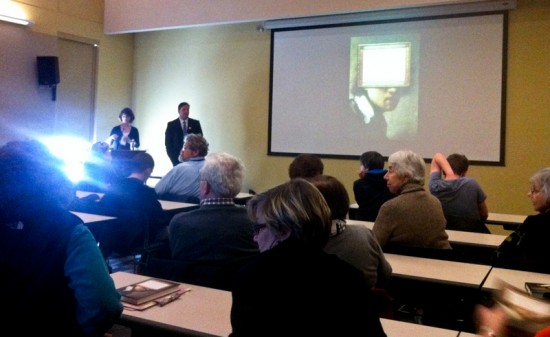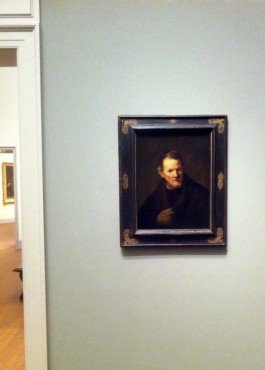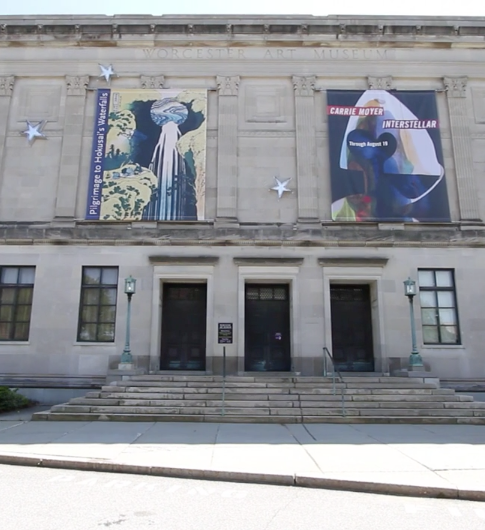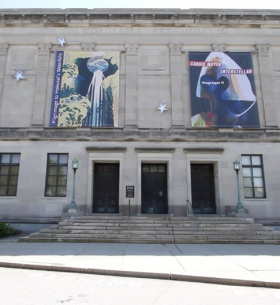

After spending nearly 15 years working in the national security arena, a time shared between Homeland Security and the Federal Aviation Administration’s Security Division, it made perfect sense for Anthony Amore to make the leap to the Isabella Stewart Gardner Museum where he presently works as the Director of Security and Chief Investigator. Charged with both protecting the current collection of the museum and procuring the artwork stolen during the famous 1990 heist, which included three Rembrandts, Amore has found himself getting quite the education on art theft—specifically involving Rembrandts. When investigating these types of thefts around the globe, it is only natural to turn the attention to our beloved Worcester Art Museum where a chapter in Amore’s book, Stealing Rembrandts: The Stories of Notorious Art Heists, is dedicated to the world’s first recorded armed robbery of a museum.
 On Amore’s March 4th visit to the Worcester Art Museum he retold the story, in depth, about the heist and how it’s thieves’ plan conformed to the archetype of unprepared thefts. To start, even if a theft is successful, it proves to be impossible to part with the artwork for money. Even if finding a buyer, the non-expiring statute of limitations of being in possession of stolen artwork makes it less likely to sell the art to someone willing to pay significantly less than the recorded value. In the case of the heist at the Worcester Art Museum in May of 1972, the “perfect plan” was flawed from the beginning. One of the thieves was escorted out of the museum for not knowing the smoking policy while the two, who returned later, insisted on having an armed gun. The orchestrator of the heist, Florian “Al” Monday, reluctantly gave the men a gun, armed with a single round of ammunition. While the thieves took the artwork after scaring two fourteen year old girls—one of which, now an adult, was present at Amore’s lecture—they made their way through the Renaissance Court walking across the Antioch mosaic where the unarmed guard, Philip J. Evans, tried to stop them from walking across the 3rd century mosaic. Fearing resistance, the guard was shot and the two men fled to their stolen station wagon waiting outside. Upon getting to the car, instead of placing the artwork flat in the back, they carelessly threw two pieces into the backseat and held the third to the roof from outside the passenger’s window. Needless to say, the thieves were caught and the artwork returned, which included The Brooding Woman and Head of a Woman by Paul Gauguin, Mother and Child by Pablo Picasso, and St. Bartholomew by Rembrandt, a collection of works worth over one million dollars.
On Amore’s March 4th visit to the Worcester Art Museum he retold the story, in depth, about the heist and how it’s thieves’ plan conformed to the archetype of unprepared thefts. To start, even if a theft is successful, it proves to be impossible to part with the artwork for money. Even if finding a buyer, the non-expiring statute of limitations of being in possession of stolen artwork makes it less likely to sell the art to someone willing to pay significantly less than the recorded value. In the case of the heist at the Worcester Art Museum in May of 1972, the “perfect plan” was flawed from the beginning. One of the thieves was escorted out of the museum for not knowing the smoking policy while the two, who returned later, insisted on having an armed gun. The orchestrator of the heist, Florian “Al” Monday, reluctantly gave the men a gun, armed with a single round of ammunition. While the thieves took the artwork after scaring two fourteen year old girls—one of which, now an adult, was present at Amore’s lecture—they made their way through the Renaissance Court walking across the Antioch mosaic where the unarmed guard, Philip J. Evans, tried to stop them from walking across the 3rd century mosaic. Fearing resistance, the guard was shot and the two men fled to their stolen station wagon waiting outside. Upon getting to the car, instead of placing the artwork flat in the back, they carelessly threw two pieces into the backseat and held the third to the roof from outside the passenger’s window. Needless to say, the thieves were caught and the artwork returned, which included The Brooding Woman and Head of a Woman by Paul Gauguin, Mother and Child by Pablo Picasso, and St. Bartholomew by Rembrandt, a collection of works worth over one million dollars.
Within Amore’s book, dozens of other thefts are described where the Rembrandts are returned safely, or in rare cases, not returned at all, or, in even rarer cases, destroyed. His lectures and constant publicity of the 1990 heist aim to bring a public awareness of the theft with the goal to have the pieces restored to the walls, still sitting empty, at the Isabella Stewart Gardner Museum. A $5-million reward also helps to aid the recovery efforts.
The Worcester Art Museum, the second largest museum in New England, boasts a prestigious collection of both classics from the masters to contemporary staples from the soon-to-bes. In addition, the programs at the Worcester Art Museum, including lecture series like the one that brought Amore to the museum are valuable benefits to it’s members. Whether there for the art, library, or educational programs for children and adults, the Worcester Art Museum‘s programs are a great way to stay abreast of what’s happening in the art world.

 “Opening the front doors of the museum, with the help of our members and community, jumpstarts our museum-wide philosophy of providing access,” said Waschek. “In addition, the Salisbury Street entrance allows our guests to enter directly into the Renaissance Court which we believe is truly the cornerstone of the Museum,” he added.
“Opening the front doors of the museum, with the help of our members and community, jumpstarts our museum-wide philosophy of providing access,” said Waschek. “In addition, the Salisbury Street entrance allows our guests to enter directly into the Renaissance Court which we believe is truly the cornerstone of the Museum,” he added.


